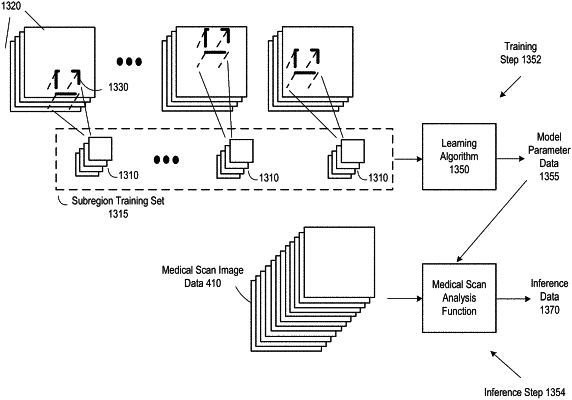| CPC G06Q 10/06315 (2013.01) [A61B 5/7264 (2013.01); G06F 3/0482 (2013.01); G06F 3/0484 (2013.01); G06F 9/542 (2013.01); G06F 16/245 (2019.01); G06F 18/214 (2023.01); G06F 18/217 (2023.01); G06F 18/2115 (2023.01); G06F 18/2415 (2023.01); G06F 18/41 (2023.01); G06F 21/6254 (2013.01); G06N 5/04 (2013.01); G06N 5/045 (2013.01); G06N 20/00 (2019.01); G06N 20/20 (2019.01); G06Q 20/14 (2013.01); G06T 3/40 (2013.01); G06T 5/002 (2013.01); G06T 5/008 (2013.01); G06T 5/50 (2013.01); G06T 7/0012 (2013.01); G06T 7/0014 (2013.01); G06T 7/10 (2017.01); G06T 7/11 (2017.01); G06T 7/187 (2017.01); G06T 7/44 (2017.01); G06T 7/97 (2017.01); G06T 11/001 (2013.01); G06T 11/006 (2013.01); G06T 11/206 (2013.01); G06V 10/225 (2022.01); G06V 10/25 (2022.01); G06V 10/764 (2022.01); G06V 10/82 (2022.01); G06V 30/19173 (2022.01); G06V 40/171 (2022.01); G16H 10/20 (2018.01); G16H 10/60 (2018.01); G16H 15/00 (2018.01); G16H 30/20 (2018.01); G16H 30/40 (2018.01); G16H 40/20 (2018.01); G16H 50/20 (2018.01); H04L 67/01 (2022.05); H04L 67/12 (2013.01); A61B 5/055 (2013.01); A61B 6/032 (2013.01); A61B 6/5217 (2013.01); A61B 8/4416 (2013.01); G06F 18/2111 (2023.01); G06F 18/24 (2023.01); G06F 40/295 (2020.01); G06Q 50/22 (2013.01); G06T 7/70 (2017.01); G06T 2200/24 (2013.01); G06T 2207/10048 (2013.01); G06T 2207/10081 (2013.01); G06T 2207/10088 (2013.01); G06T 2207/10116 (2013.01); G06T 2207/10132 (2013.01); G06T 2207/20076 (2013.01); G06T 2207/20081 (2013.01); G06T 2207/20084 (2013.01); G06T 2207/30004 (2013.01); G06T 2207/30008 (2013.01); G06T 2207/30016 (2013.01); G06T 2207/30061 (2013.01); G06V 30/194 (2022.01); G06V 2201/03 (2022.01); G16H 50/30 (2018.01); G16H 50/70 (2018.01)] | 20 Claims |

|
1. A method comprising:
generating, in a first temporal period, a longitudinal lesion model by performing a training step utilizing a plurality of sets of longitudinal data, wherein dates of medical scans of different ones of the plurality of sets of longitudinal data have relative time differences corresponding to different time spans, wherein each set of the plurality of sets of longitudinal data corresponds to one of a plurality of different patients, and wherein one set of longitudinal data of the plurality of sets of longitudinal data corresponds a first patient and is determined based on:
a first lesion volume measurement of a first lesion detected in a first medical scan of the one set of longitudinal data; and
a second lesion volume measurement of the first lesion detected in a second medical scan of the one set of longitudinal data, wherein the second medical scan has a more recent scan date than the first medical scan;
receiving, in a second temporal period that is strictly after the first temporal period, a third medical scan that is associated with a second patient that is distinct from the first patient;
utilizing the longitudinal lesion model to perform an inference step on the third medical scan to generate, for a second lesion detected in the third medical scan, a plurality of lesion change prediction data for a corresponding plurality of different projected time spans ending after a current date based on the different time spans; and
transmitting at least one lesion change prediction data of the plurality of lesion change prediction data for display.
|